- Get link
- X
- Other Apps
- Get link
- X
- Other Apps
During the pandemic lockdown period, I struggled with not being able to get out and see art ‘in real life’. When I wrote the funding application to Arts Council England for the Grow Your Own Artist project, I thought it was important to include visiting somewhere inspiring and exciting: something that I normally wouldn’t be able to do for financial reasons.
I find visiting art exhibitions very stimulating. It really helps me to generate ideas and connect them to my own art practice. Even the act of travelling somewhere allows a certain amount of thinking time and adds something to the whole experience.
Lux
I had originally planned to visit a festival of creative and digital culture called Signal, which takes place annually in Prague. Unfortunately for my plans, an operation I had been waiting over twelve months for was eventually scheduled for October, so I had to cancel that trip. Rather than miss the opportunity of seeing something special, that I couldn’t get to without the funding, I did some research and discovered another international festival in Helsinki, called Lux. Hoping I would have recovered well enough by January to do several days of walking around, I booked the flights and hotel and started researching the city’s artistic offerings.
Lux is a light festival that happens across the city; it was split into three main areas of Helsinki, which I explored over a couple of nights. I find light festivals interesting, as they are often quite experiential, bringing elements of art, performance, sound and entertainment together. The artworks can be quite theatrical, and some of those shown in Lux responded to the actions of the audience, changing light and sound sequences accordingly.
I particularly enjoyed Whale Ghost, by French artists Pitaya, in which lights like the bones of a whale changed colour and shape, suspended at some height above the crowd. Ghostly whale song played as we stood together in the snow beneath the artwork, contemplating nature and our impact on the world. This creative duo also created a piece with a flock of origami birds, seemingly flying through the trees next to a frozen lake.
Pitaya (France), Whale Ghost, at Lux Helsinki. The combination of the moving lights of the sculpture and the sound had a poignant effect.
Overall the exhibition showed a breadth of approaches to using light as a material, from Yle’s The Face of the City, a large outdoor projection mapped piece, ‘inspired by the diverse visual catalogue and soundscape of the city, as well as by Finnish art music of the modernist period’ to more intimate, indoor work such as Yasuhiro Chida’s Analemma, a room filled with thin cords that interrupted beams of light, like a room filled with fireflies. Only a handful of people could enter the space at once, so the queue became part of the experience (the anticipation, the boredom of queuing, the excitement of reaching the front).
 |
| Yle (Finland), The Face of the City, at Lux Helsinki |
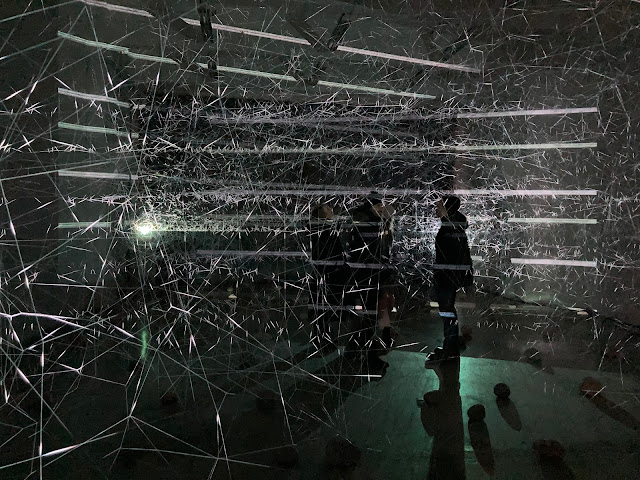 |
| Yasuhiro Chida (Japan), Analemma, at Lux Helsinki |
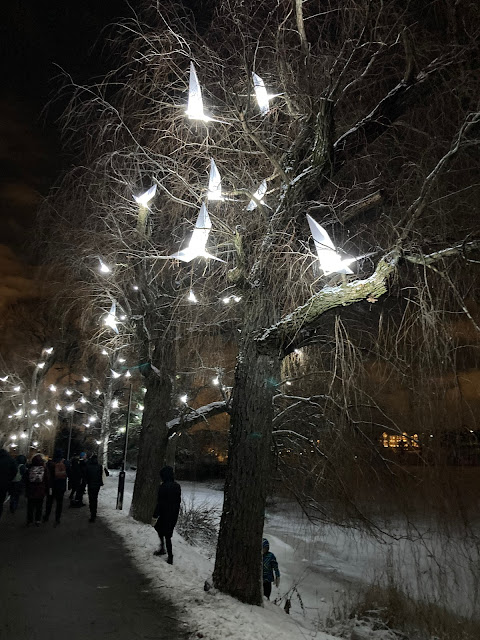 |
| Pitaya (France), L'Envol, at Lux Helsinki |
%20The%20Dresses%20Lux%20Helsinki_image%20Rebecca%20Farkas%202023.jpeg) |
| Tae Gon Kim (Korea), The Dresses, at Lux Helsinki |
It was bracing to visit outdoor artworks in such icy conditions (it was -10ºC) and interesting to see that there was a wide mixture of visitors. A light festival is a very accessible kind of art, in that it is mainly easy to understand without too much explanation, it is immediate and, in this case, free to attend. Importantly, it takes place in city spaces that belong to everyone, instead of behind closed gallery doors, although Helsinki’s galleries also proved popular…
Kiasma
Markus Copper
You have to pay to go into Helsinki’s galleries, but I was lucky enough to plan my visit to coincide with the first Friday of the month, a date when entry to Kiasma, the Finnish National Gallery, is free. Inside, I looked around a retrospective exhibition of work by Markus Copper. This included many dark pen and ink drawings, some of which looked like work from graphic novels, and some large sculptural pieces that had movement and sound.
Interestingly, Copper went through a period of making pieces that incorporated actual danger. These included a series of works that were designed to explode when all of them were pieced together, and a large metal sphere that had a mechanism that would sense movement and roll towards it in order to crush someone! Thankfully, these were no longer in operation for the show and we could look around in safety.
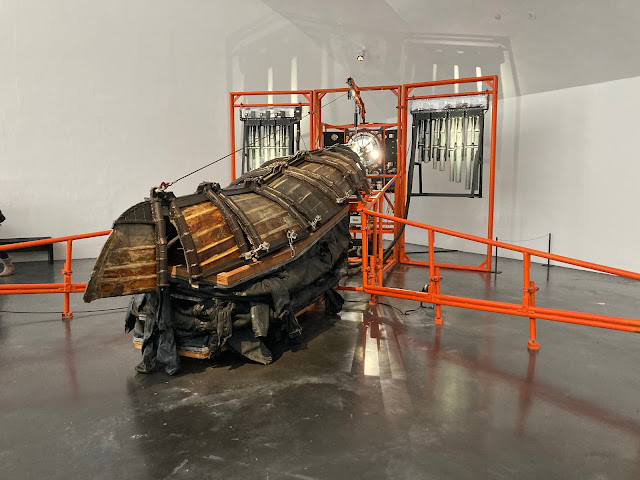 |
| Markus Copper, Whaling Station, 2009 |
The big sculptures, shown on the building’s top floor, had mechanisms that made them spring to life, and they also played sounds. My favourite was a sculpture that used an upside-down wooden rowing boat, with an underside made of discarded leather jackets, opening up like bellows. Organ pipes played a strange tune, building to a crescendo, at which point the sculpture reared up towards the ceiling, like a whale breaking the waves. It was quite a spectacle and it made me contemplate the performative nature of this kind of piece, and the anticipation of waiting for the ‘show’ to happen.
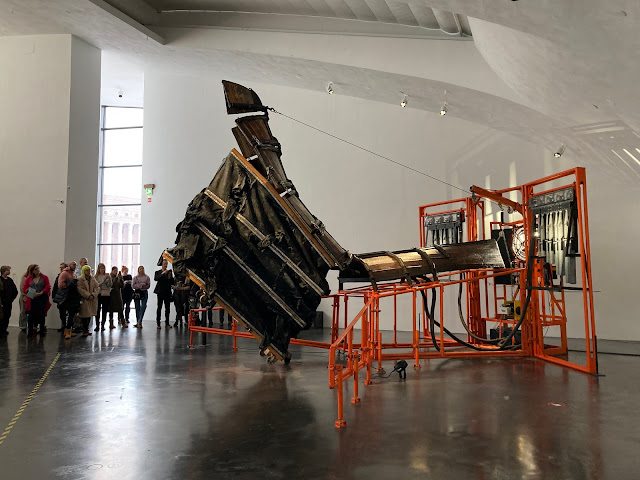 |
| Markus Copper, Whaling Station, 2009 |
Navigating North
At the same gallery, an exhibition called Navigating North showed a huge breadth of practice from artists either from northern Finland or who live there, exploring themes related to humans and nature. There were some really thought provoking works in this show and it revealed something familiar: a north / south divide, between the more prosperous south of the country and more deprived areas in the north. This is something that we also experience in the UK.
 |
| Images above from Navigating North, at Miasma |
The Quiet Parade
The third gallery exhibition I saw was at Amos Rex, and this was something I was very excited to discover when I was researching what to see in Helsinki. The Quiet Parade was created by Belgian artist Hans Op de Beeck and seemed to link well into my research into the memento mori tradition. It did not disappoint.
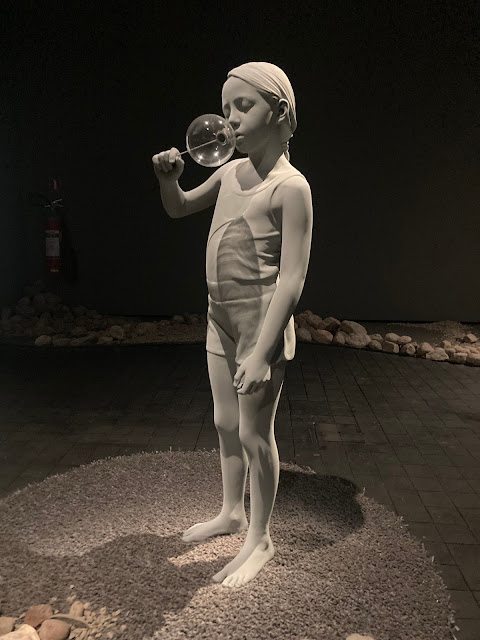 |
| Tatiana from The Quiet Parade by Hans Op de Beeck |
Entering the space was like wandering directly into a waking dream. Everything within the gallery had been landscaped, with pathways between extremely lifelike sculptures, and everything was in shades of grey – like walking into a black and white film. A soundscape added to the dreamlike quality, and, as I explored the space, I realised that we, the visitors, were the only colourful components of this strange world. The figures were hyper real, from a man sitting on a horse to two teenagers hanging out on a rock. A giant book, grapes and a skull were arranged in a traditional memento mori scene.
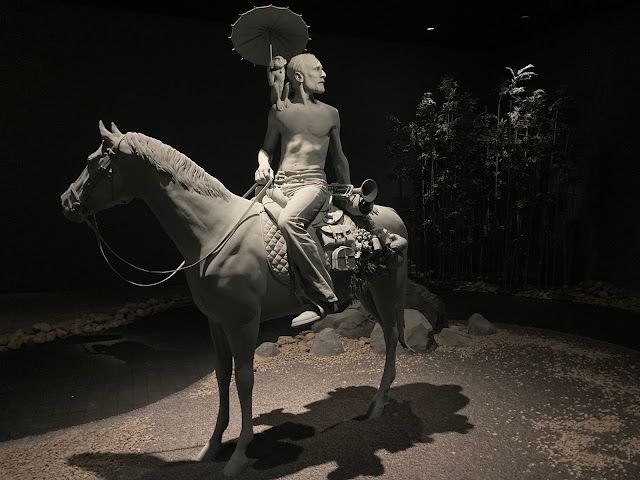 |
| The Horseman, a figure from The Quiet Parade by Hans Op de Beeck |
 |
| The Cliff, figures from The Quiet Parade by Hans Op de Beeck |
 |
| Vanitas XL, from The Quiet Parade by Hans Op de Beeck |
The centrepiece was Danse Macabre, a fairground carousel, populated by skeletons in formal Victorian dress, alongside trays filled with opulent food and drink. This installation really made me consider what is possible in a gallery setting and how the whole atmosphere can be changed, to challenge the senses and provide a complete and immersive experience for the visitor. There was a strange sense that time wasn’t happening within that space, a place both eerie and thought provoking.
 |
| Danse Macabre, from The Quiet Parade by Hans Op de Beeck |
 |
| Danse Macabre (detail), from The Quiet Parade by Hans Op de Beeck |
I am immensely grateful for the opportunity to spend a few days in a different city and see so many artworks, provided by the funding I received from Arts Council England. These shows, and others I have seen, have really fed into my art practice, helped me to think bigger and formulate new ideas for recent art proposals I have written. Whether it’s somewhere completely new, or a more local trip, seeing art ‘in real life’ helps to feed my creativity and my soul. It’s difficult to make meaningful art without it.
%20Quietly%20Speaking%20Colors%20Lux%20Helsinki_image%20Rebecca%20Farkas%202023.jpeg)
%20The%20Physical%20Possibility%20of%20Death%20in%20the%20Mind%20of%20Someone%20Living_image%20Rebecca%20Farkas%202023.jpeg)




Comments
Post a Comment